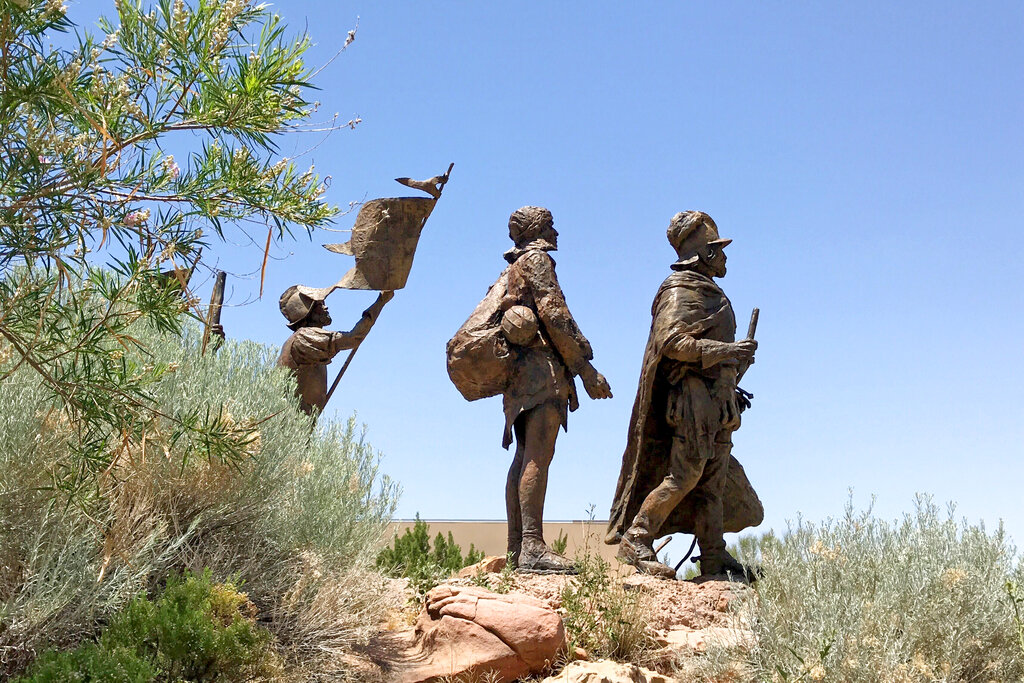
The bronze statue of Don Juan de Oñate is leading a group of Spanish settlers from an area near what is now Ciudad Chihuahua, Mexico. (AP)
ALCALDE, New Mexico — A statue of a Spanish conqueror was removed Monday from public display at a cultural center in northern New Mexico to safeguard it from possible damage and avoid civil unrest, hours before scheduled protests of the memorial.
A forklift pried the massive bronze statue of Juan de Oñate from a concrete pedestal in Alcalde. Cheers erupted among bystanders who saw the memorial as an affront to indigenous people and an obstacle to greater racial harmony, though several people also arrived to defend the tribute to Oñate.
Rio Arriba County Manager Tomas Campos said the statue was placed in storage for its own protection. He expects the three-member county commission to solicit public comment on what to do next with the public works project commissioned by the state in the early 1990s.
“This is public property and I’m not going to allow it to be damaged,” Campos said. “Plus, I don’t feel like risking my sheriff’s deputies or state police to defend it.”
The statue of Oñate at a heritage education center has been a source of criticism for decades.
Oñate, who arrived in present-day New Mexico in 1598, is celebrated as a cultural father figure in communities along the Upper Rio Grande that trace their ancestry to Spanish settlers. But he’s also reviled for his brutality.
To Native Americans, Oñate is known for having ordered the right feet cut off of 24 captive tribal warriors that was precipitated by the killing of Onate’s nephew. In 1998, someone sawed the right foot off the statue — an incident that weighed in the decision to stash away the statue.
Luis Peña of Espanola, an artist and computer network engineer who started a public petition last week to remove the statue permanently, said he was heartened to see it taken off display.
“It’s about time,” he said. “I think people are finding their voices. … They can enact change and start the process of picking up all this trash that has been lying around for decades.”
Removal of the statue was followed by a few heated roadside discussions about local colonial history, under the gaze of a half-dozen sheriff’s deputies from Rio Arriba County.
Tony Valerio, 65, rushed to the site after a neighbor alerted him that statue was being taken down.
“He’s my hero. He brought a lot of good things to New Mexico,” Valerio said of Oñate. “What’s next? The Statue of Liberty?”
Elena Ortiz, who organized a protest at the site for Monday night, said many people have grown uncomfortable with the Oñate statue.
“There are as many Hispanics, Latinos and Chicanos who are against this as there are Native Americans,” Ortiz said. “They also don’t want to be identified with symbols of conquest.”
Gov. Michelle Lujan Grisham, who has campaigned on her heritage as a 12th-generation New Mexican, called the statue’s removal a “step in the right direction” in a Twitter post.
By Monday evening, dozens had joined a celebratory gathering with Native American dancing and drumming outside the cultural center where demonstrators left hand prints in red paint on the empty statue pedestal.
A separate demonstration in Albuquerque was aimed at the removal of another Oñate likeness that is part of a caravan of Spanish colonists set in bronze outside a city museum.
Monuments to European conquerors and colonists around the world are being pulled down amid an intense re-examination of racial injustices in the wake of George Floyd’s death at the hands of police.
Albuquerque city officials announced Saturday they will convene a council of community leaders and artists to consider the concerns about the public art piece as they look for “creative solutions.”
Titled “La Jornada,” the sculpture depicts Oñate leading a group of Spanish settlers to what was then the northern-most province of New Spain in 1598. The collection of statues includes an indigenous guide, a priest, women settlers and soldiers. The names of the families who accompanied Oñate are listed on plaques below as part of the “Wall of Spanish Ancestral Heritage.”
“Recent calls for altering ‘La Jornada’ remind us that works of art often challenge communities to debate ideas, pursue empathy, grapple with multiple perspectives, reconcile conflict and interrogate history,” said Shelle Sanchez, head of the city’s Cultural Services Department.
“La Jornada” is one of two pieces on museum property that were installed to reflect part of New Mexico’s history, city officials said. The other by artist Nora Naranjo Morse of Santa Clara Pueblo is meant to be a place of solace and reflection that was commissioned as a response to the caravan.
In northern New Mexico, annual costumed tributes to Spanish conquistadors, including Oñate, have been scaled back or canceled in recent years in deference to local indigenous communities and new revelations about the subjugation and enslavement of Native American servants and people of mixed ancestry.